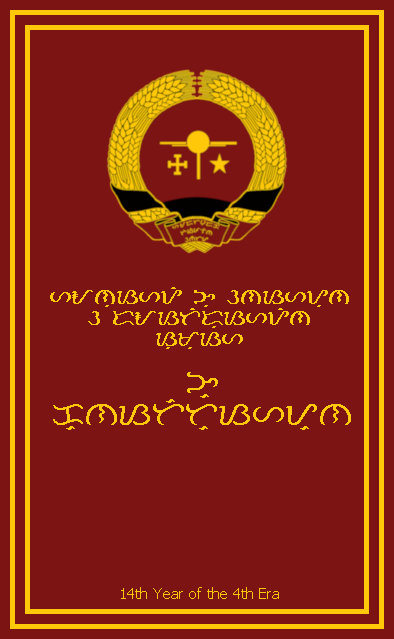Constitution of Janpia
Jump to navigation
Jump to search
This article is incomplete because it is pending further input from participants, or it is a work-in-progress by one author. Please comment on this article's talk page to share your input, comments and questions. Note: To contribute to this article, you may need to seek help from the author(s) of this page. |
| Constitution (Fundamental Law) of the Janpian Union of Revolutionary States Traditional Janpian: Janosche Unschon o Rasteruschen Sumosch no Konstituschon. | |
|---|---|
 Outer Cover of the Constitution of the Janpian Union of Revolutionary States | |
| Jurisdiction | |
| Created | October 12, 1951 CE (11th year of the 4th era) |
| Ratified | February 4th, 1954 CE (14th year of the 4th era) |
| Date effective | February 4th, 1954 CE (14th year of the 4th era) |
| System | Unitary Lorist Party-State |
| Branches | 4 ( Office of the People's Marshal, Party Central Committee, Union of Party Members Committee, Revolutionary Ministry of the Workers' Union) |
| Chambers | Bicameral
• Union of Party Members Committee |
| Executive | People's Marshal |
| Judiciary | Janpian Revolutionary Justice Tribunal under the Party Central Committee |
| First executive | Haschukio Toraigescho (debated) |
| Amendments | None |
| Location | Fort Kalinka, Ministry of Collective Information and Archives Building |
| Commissioned by | Janpian Union of Government Workers' Party |
| Author(s) | Unknown |
The Constitution of Janpia, formally known as the Constitution of the Janpian Union of Revolutionary States (Janpian Traditional: Janosche Unschon o Rasteruschen Sumosch no Konstituschon), is the constitution or the absolute law with the purpose of establishing the Janpian Union of Government Worker's Party as the governing authority. The author is unknown, but historians suggested that it was written collectively based on the earlier unwritten rules by the Janpian Workers' Party, with additional changes.